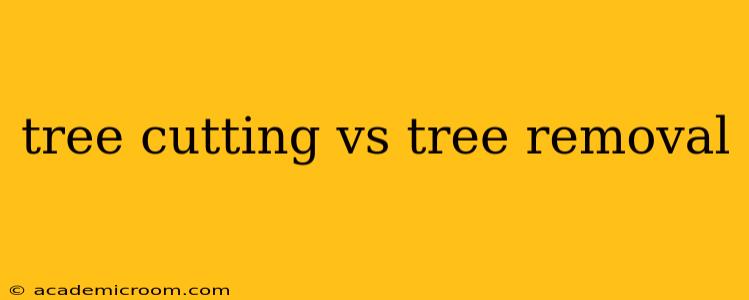Choosing between "tree cutting" and "tree removal" might seem simple, but there's a crucial distinction that impacts safety, cost, and the overall health of your property. While the terms are often used interchangeably, they represent different approaches to dealing with unwanted or hazardous trees. This comprehensive guide will clarify the differences and help you make the right choice for your situation.
What is Tree Cutting?
Tree cutting, in its simplest form, involves felling a tree, often to ground level. This usually focuses on removing the trunk and major branches. It's a relatively straightforward process suitable for smaller trees or those in open areas where there's minimal risk of damage to surrounding structures or property. Think of pruning a large branch – tree cutting is an amplified version of this, but still generally confined to the tree itself.
Key Characteristics of Tree Cutting:
- Scope: Primarily focused on the tree itself. Stumps and smaller roots are usually left behind.
- Complexity: Generally less complex and time-consuming than tree removal.
- Cost: Typically less expensive than tree removal.
- Suitability: Best for smaller trees, open areas, and situations where stump removal isn't necessary.
What is Tree Removal?
Tree removal is a more comprehensive process encompassing the complete elimination of a tree, including the trunk, branches, and roots. This often requires specialized equipment and expertise, particularly for larger trees or those located in challenging environments. The goal isn't simply to fell the tree but to remove it completely and safely, minimizing any potential damage or hazards.
Key Characteristics of Tree Removal:
- Scope: Complete removal of the tree, including the stump and significant portions of the root system.
- Complexity: More complex and often requires specialized equipment and techniques.
- Cost: Typically more expensive than tree cutting.
- Suitability: Necessary for larger trees, trees in confined spaces, trees posing a safety risk, or situations requiring complete removal.
What are the differences between tree cutting and tree removal?
The primary difference lies in the thoroughness of removal. Tree cutting is a partial removal, while tree removal is a complete removal. This seemingly minor distinction has significant implications:
1. Extent of Removal:
- Tree Cutting: Removes the above-ground portion of the tree, leaving the stump and roots in place.
- Tree Removal: Removes the entire tree, including the stump and a substantial portion of the root system. This often requires grinding the stump to prevent regrowth and potential hazards.
2. Equipment and Expertise:
- Tree Cutting: May only require basic hand tools or a chainsaw for smaller trees.
- Tree Removal: Often requires specialized equipment like cranes, aerial lifts, and stump grinders, and the expertise to operate them safely.
3. Safety Considerations:
- Tree Cutting: Safety concerns are generally lower in open areas with smaller trees.
- Tree Removal: Requires meticulous planning and execution to prevent damage to surrounding property or injury to personnel. Risk assessment is crucial.
4. Cost:
- Tree Cutting: Usually less expensive due to its reduced scope and labor.
- Tree Removal: More expensive due to the additional labor, equipment, and expertise required.
How do I choose between tree cutting and tree removal?
The decision depends on several factors:
- Size and Location of the Tree: Larger trees in confined spaces typically require removal.
- Condition of the Tree: Diseased or decaying trees may pose safety risks and necessitate removal.
- Proximity to Structures and Utilities: Trees near buildings, power lines, or other utilities generally require careful removal.
- Your Budget: Tree cutting is the more budget-friendly option.
- Future Plans for the Area: If you plan to landscape or build in the area, complete removal might be necessary.
What if I need to remove a very large or hazardous tree?
For very large or hazardous trees, always consult with a certified arborist. They can conduct a thorough assessment, determine the safest and most effective removal method, and obtain necessary permits if required. Attempting to remove a large tree without proper training and equipment is extremely dangerous.
Is stump removal always necessary with tree removal?
While stump removal isn't always mandatory with tree removal, it's highly recommended. Stumps can pose tripping hazards, attract pests, and hinder future landscaping efforts. Stump grinding efficiently removes the stump below ground level, preventing regrowth and creating a clean, safe space.
By understanding the differences between tree cutting and tree removal, you can make an informed decision that best suits your needs and ensures the safety of your property and those around you. Remember, when in doubt, consult a professional arborist.
